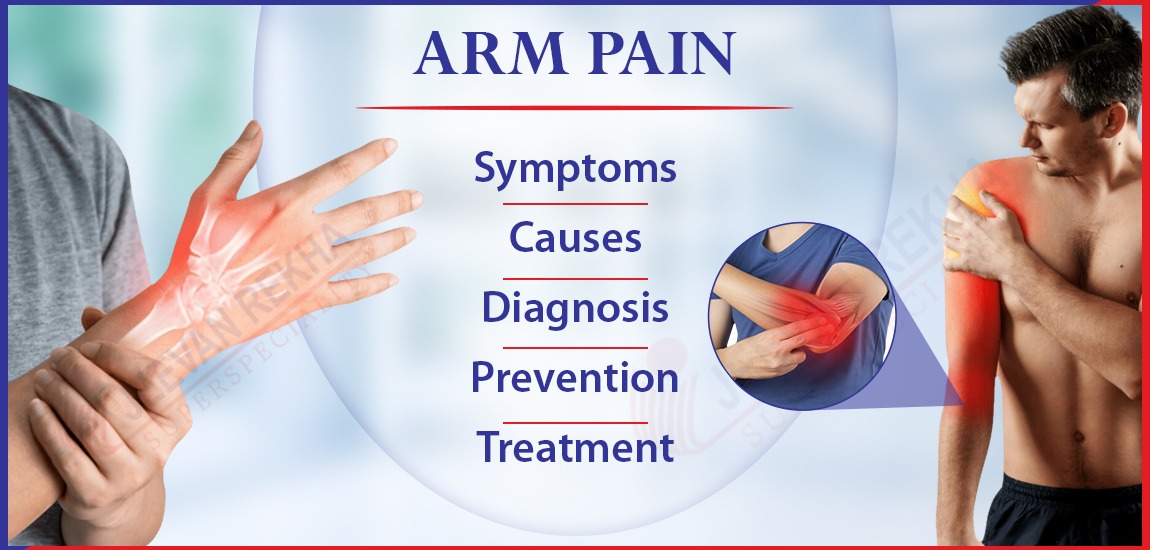
- By JRSH Admin
- In Health and Tips,
- Posted October 07, 2023
Arm Pain: Symptoms, Causes, Diagnosis, Prevention and Treatments
What is Arm Pain?
An arm pain can be described as any discomfort or pain experienced in the arm. There may be discomfort in the shoulders, elbows, and wrists as a result of it.
Arm pain can be caused by a variety of factors. Overuse or injury are the most common causes. Inflammation may begin quickly and end or increase gradually, depending on the cause.
Symptoms of Arm Pain
Arm pain can have various causes, and the symptoms can vary depending on the underlying issue. Common symptoms of arm pain include:
- Pain: This is the primary symptom. It can range from mild to severe and may be described as aching, throbbing, sharp, burning, or stabbing. The location of the pain can also vary, affecting the upper arm, lower arm, or specific parts of the arm like the shoulder, elbow, wrist, or hand.
- Swelling: If there is inflammation or an injury, the affected arm may become swollen. Swelling can be visible and may make the arm feel puffy or tight.
- Weakness: Some people with arm pain may experience weakness in the affected arm. This can make it difficult to perform tasks that require strength or coordination.
- Stiffness: Stiffness in the arm may make it challenging to move it freely. This can be due to muscle tension, joint issues, or other underlying causes.
- Numbness or tingling: If the nerves in the arm are affected, you may experience numbness or tingling sensations. This can radiate from the neck or shoulder down to the hand.
- Limited range of motion: Pain and stiffness can reduce the ability to move the arm through its full range of motion. This can affect activities like reaching, lifting, or bending the arm.
- Redness or warmth: In some cases, arm pain may be accompanied by redness or warmth, which can indicate inflammation or infection.
- Bruising: If the arm pain is the result of an injury, bruising may develop at the site of the injury or spread to other areas of the arm.
- Muscle spasms: Painful muscle spasms or cramps in the arm can also be a symptom of certain conditions or overuse.
- Pain with specific movements: Arm pain may worsen or improve with certain movements or activities. For example, pain might be exacerbated when lifting objects, reaching overhead, or performing repetitive tasks.
Also read: Knee Pain: Treatment, Causes, Remedies, Symptoms
Causes of Arm Pain
There are numerous causes of arm pain, including:
- Muscle strain: overuse or injury to arm muscles.
- Joint Problems: Conditions like arthritis or bursitis affecting the shoulder, elbow, or wrist.
- Nerve Compression: Issues like carpal tunnel syndrome or pinched nerves.
- Bone Issues: Fractures, osteoporosis, or bone infections.
- Vascular Problems: Blood clots, arterial blockages, or inflammation.
- Heart Issues: A heart attack or angina can sometimes cause arm pain.
- Infections: Infections in the arm or systemic infections.
- Repetitive Stress: Repetitive motions or overuse injuries.
- Trauma: Accidents, falls, or sports injuries.
- Autoimmune diseases: Lupus and rheumatoid arthritis are examples of autoimmune diseases.
- Referenced Pain: Pain from another part of the body, such as the neck, can radiate to the arm.
Diagnosis of Arm Pain
The diagnosis of arm pain involves a systematic approach by a healthcare professional to identify the underlying cause. Here are the key steps typically involved in diagnosing arm pain:
- Medical History: The doctor will begin by taking a detailed medical history, asking about the onset of pain, its location, duration, and any triggering events or activities. They will also inquire about any relevant medical conditions, recent injuries, or previous arm pain episodes.
- Physical Examination: A thorough physical examination is conducted to assess the arm's range of motion, strength, and any visible signs of swelling, redness, or deformity. The doctor may also examine other areas, such as the neck, shoulder, and back, as referred pain from these regions can manifest as arm pain.
- Imaging Studies: Depending on the suspected cause, the doctor may order imaging studies to visualize the structures in the arm. Common imaging techniques include X-rays (for bone injuries), ultrasound (for soft tissue and vascular issues), CT scans, or MRI scans (for detailed imaging of muscles, tendons, nerves, and joints).
- Electrodiagnostic Tests: In cases involving nerve-related issues, such as carpal tunnel syndrome or radiculopathy, electrodiagnostic tests like electromyography (EMG) and nerve conduction studies (NCS) may be performed to assess nerve function and identify any abnormalities.
- Blood Tests: Blood tests may be ordered to check for signs of infection, inflammation, autoimmune diseases, or other systemic conditions that could be causing arm pain.
- Specialized Tests: Depending on the suspected cause, the doctor may order additional specialized tests. For example, if cardiovascular issues are a concern, an ECG (electrocardiogram) may be performed to evaluate heart function.
- Diagnostic Injections: In some cases, diagnostic injections of medications or anesthetics may be administered to specific joints or nerve regions to help pinpoint the source of pain.
- Patient Assessment: The healthcare provider will also consider the patient's overall health and lifestyle factors, such as occupation, hobbies, and activities, which may contribute to or exacerbate arm pain.
Risk Factors of Arm Pain
Risk factors for arm pain include:
- Overuse: Repeated or excessive use of the arm or specific muscles.
- Age: Aging increases the risk of joint and muscle problems.
- Injuries: Accidents, falls, or sports-related injuries.
- Occupation: Jobs with repetitive motions or heavy lifting.
- Poor Posture: Incorrect ergonomics and posture during work or activities.
- Medical Conditions: Conditions like arthritis, diabetes, or heart disease can contribute.
- Obesity: Excess weight can strain joints and muscles.
- Smoking: Smoking may impair blood flow and healing.
- Family History: Genetic factors can play a role in certain conditions.
- Stress: Psychological stress can exacerbate muscle tension and pain.
Treatments for Arm Pain
The treatment of arm pain depends on its underlying cause. Here are some common treatments and interventions for arm pain:
- Rest: If the arm pain is due to overuse or strain, resting the affected arm can help reduce symptoms and promote healing.
- Physical Therapy: Physical therapists can provide exercises and techniques to improve arm strength, flexibility, and range of motion. They may also use modalities like heat or ice.
- Medications:
- Pain relievers: Over-the-counter pain medications like ibuprofen (Advil, Motrin) or acetaminophen (Tylenol) can help alleviate pain and reduce inflammation.
- Prescription medications: For more severe pain, your doctor may prescribe stronger pain medications or muscle relaxants.
- Bracing or Splinting: Depending on the cause of the arm pain, wearing a brace or splint may help stabilize and support the arm while it heals.
- Injections: In some cases, corticosteroid injections may be administered to reduce inflammation and relieve pain, especially for conditions like tendonitis or bursitis.
- Hot and Cold Therapy: Using heat or cold packs on the injured area can help reduce pain and swelling.
- Physical Modalities: Physical therapists may use modalities like ultrasound, electrical stimulation, or therapeutic massage to relieve pain and promote healing.
- Occupational Therapy: If arm pain affects daily activities, an occupational therapist can provide techniques and adaptations to improve function.
- Surgery: In cases of severe injury, fractures, or certain medical conditions (e.g., carpal tunnel syndrome), surgery may be necessary to correct the problem or relieve pressure on nerves.
- Lifestyle Modifications: Changing ergonomics at work, improving posture, and making adjustments to daily activities can help prevent future arm pain.
- Weight Management: If excess weight is contributing to arm pain, weight loss, and a healthy lifestyle can be essential.
- Stress Management: Relaxation and stress management strategies can help reduce muscle tension and associated pain.
- Treatment of Underlying Conditions: If arm pain is a symptom of an underlying medical condition (e.g., arthritis, diabetes), treating the primary condition can alleviate arm pain.
Prevention of Arm Pain
To prevent arm pain:
- Proper Ergonomics: Maintain good posture at work and during activities, ensuring ergonomic setups.
- Regular Exercise: Strengthen arm muscles and improve flexibility through regular exercise.
- Stretching: Stretch arm muscles before and after physical activities.
- Rest and Recovery: Allow adequate rest between repetitive tasks or workouts.
- Weight Management: Maintain a healthy weight to reduce strain on arm joints and muscles.
- Proper Lifting Techniques: Use proper lifting techniques, bending at the knees, not the waist.
- Ergonomic Tools: Use ergonomic tools and equipment to reduce strain.
- Stress Management: Manage stress to reduce muscle tension.
- Hydration: Stay hydrated to maintain muscle health.
- Safety Precautions: Take safety precautions to prevent accidents and injuries.
- Regular Check-ups: Address underlying medical conditions through regular check-ups and treatment.
- Listening to Your Body: Pay attention to early signs of discomfort and seek timely treatment.
Implementing these preventive measures can help reduce the risk of developing arm pain and promote overall arm health.
Tags
Blog Search
Latest Posts
-
बर्ड फ्लू के लक्षण, कारण, उपचार और बचाव के उपाय जानें
December 04, 2025 -
Best Diet Plan for Menopause Weight Management
November 25, 2025 -
Pulmonary Fibrosis Treatment: Understanding Lung Scarring and Breathing Problems
November 21, 2025 -
Arrhythmia: Types, Causes, Symptoms, and Treatment
November 07, 2025 -
Silent Heart Attack: Causes, Symptoms and Treatment
October 24, 2025




